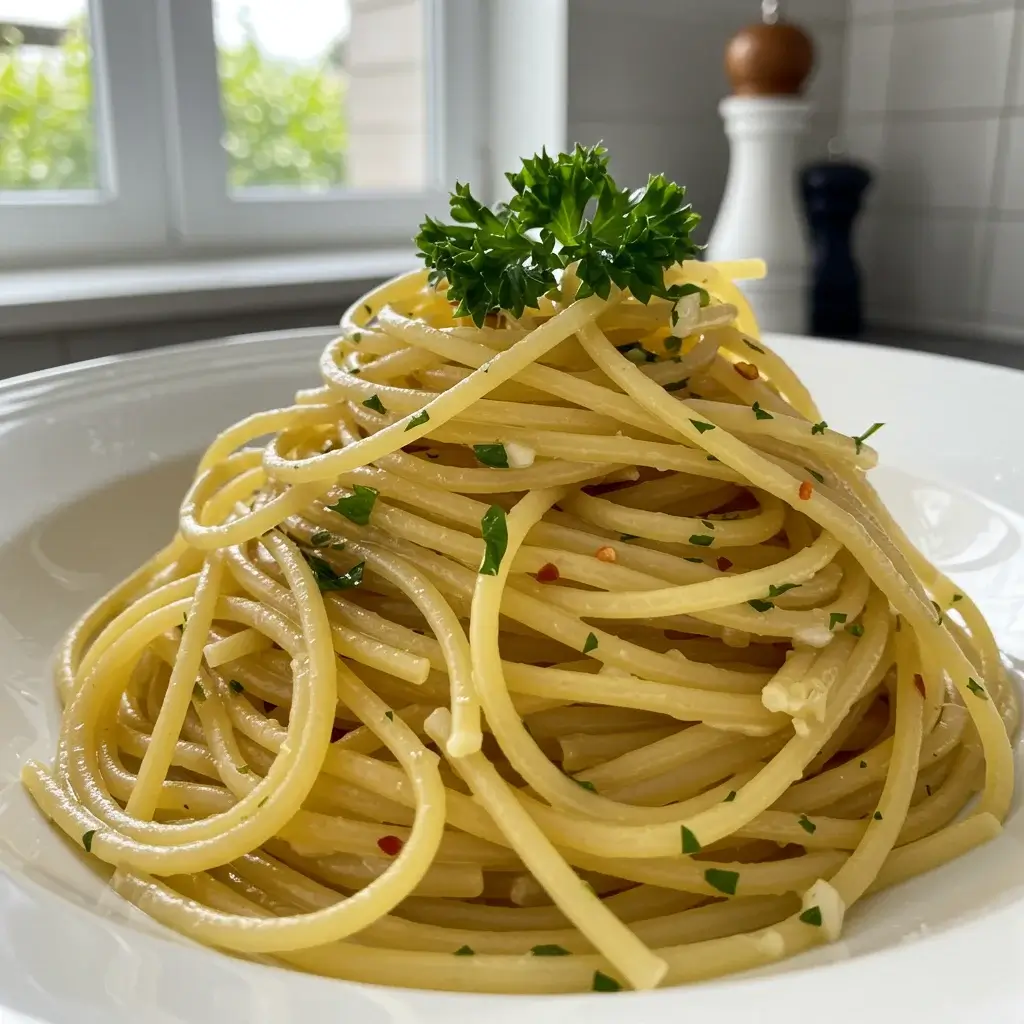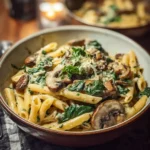Introduction
Spaghetti with garlic and oil, or “Spaghetti Aglio e Olio,” is a quintessential Italian pasta dish that embodies simplicity and flavor. Originating from Naples, this dish is a testament to the magic that can be created with minimal ingredients. Known for its tantalizing aroma and rich taste, spaghetti with garlic and oil is perfect for those who crave a quick yet satisfying meal. In this article, we will explore the ingredients, preparation, nutrition facts, serving suggestions, and more, ensuring you can recreate this timeless classic in your kitchen.
Ingredients
Creating the perfect spaghetti with garlic and oil requires only a handful of ingredients, most of which are likely already in your pantry. Here’s what you’ll need:
- Spaghetti – 400 grams
- Extra Virgin Olive Oil – 1/2 cup
- Garlic – 4 cloves, thinly sliced
- Red Pepper Flakes – 1 teaspoon (adjust to taste)
- Fresh Parsley – 1/4 cup, finely chopped
- Salt – to taste
- Parmesan Cheese – grated, for serving (optional)
- Freshly Ground Black Pepper – to taste
Instructions
Follow these simple steps to prepare a delicious plate of spaghetti with garlic and oil:
- Boil the Pasta:
- Fill a large pot with water, add a generous pinch of salt, and bring it to a boil.
- Add the spaghetti and cook according to package instructions until al dente.
- Reserve 1 cup of pasta water and then drain the spaghetti.
- Prepare the Garlic and Oil:
- While the pasta is cooking, heat the olive oil in a large skillet over medium heat.
- Add the sliced garlic and sauté until it turns golden brown, being careful not to burn it.
- Add the Spice:
- Stir in the red pepper flakes, allowing them to infuse the oil with their heat.
- Combine Pasta and Sauce:
- Add the drained spaghetti to the skillet, tossing it in the garlic oil mixture.
- If the pasta seems dry, gradually add some of the reserved pasta water until you achieve your desired consistency.
- Add Freshness:
- Stir in the chopped parsley, mixing well to distribute evenly throughout the pasta.
- Season to Taste:
- Add salt and freshly ground black pepper according to your preference.
- Serve:
- Transfer the spaghetti to serving plates and optionally top with grated Parmesan cheese before serving.
Nutrition Facts
Understanding the nutritional content of your meal can help you make informed dietary choices. Here’s a breakdown of the approximate nutrition facts for one serving of spaghetti with garlic and oil (without Parmesan cheese):
- Calories: 450
- Total Fat: 18g
- Saturated Fat: 2.5g
- Cholesterol: 0mg
- Sodium: 120mg
- Total Carbohydrates: 62g
- Dietary Fiber: 3g
- Sugars: 2g
- Protein: 9g
How to Serve
Spaghetti with garlic and oil, or “spaghetti aglio e olio,” is a classic Italian dish renowned for its simplicity and depth of flavor. Its versatility allows it to be served in various ways, each enhancing the dining experience and catering to different tastes. Here are several thoughtful suggestions on how to serve this delightful dish:
As a Main Course
When served as a main dish, spaghetti with garlic and oil can be incredibly satisfying. To elevate this simple preparation, consider the following tips:
- Presentation: Twirl the spaghetti using a fork or pasta tongs to create a nest-like shape on the plate. This not only makes for an appealing visual but also makes it easier for guests to serve themselves.
- Accompaniments: Pair the dish with a side of crusty bread, such as a rustic sourdough or a ciabatta loaf. The bread is perfect for soaking up the aromatic oil and garlic sauce, allowing diners to savor every last drop. For an added touch, lightly toast the bread and rub it with a clove of garlic before serving.
- Garnishes: Sprinkle freshly chopped parsley or basil on top of the spaghetti just before serving. This not only adds a pop of color but also enhances the flavor profile with fresh herbal notes. Additionally, a dusting of freshly grated Parmesan or Pecorino Romano cheese can add richness and depth.
With a Salad
Serving spaghetti with a fresh salad is an excellent way to create a balanced meal. The crispness and acidity of a salad can provide a refreshing contrast to the rich, flavorful pasta. Here are some ideas:
- Salad Composition: Choose a green salad that incorporates a variety of textures and flavors. A mix of peppery arugula, crisp romaine, and sweet cherry tomatoes can make for a vibrant base. Add thinly sliced cucumbers, radishes, and avocado for added crunch and creaminess.
- Dressing: Opt for a light vinaigrette to dress the salad. A simple lemon vinaigrette made with olive oil, fresh lemon juice, and a touch of Dijon mustard works beautifully. The acidity from the vinaigrette will cut through the richness of the oil in the pasta, providing a delightful balance.
- Add-ons: Consider including additional ingredients such as toasted nuts (like pine nuts or walnuts), crumbled feta or goat cheese, or even some roasted vegetables to enhance the salad’s flavor and nutritional profile.
With Protein
For those looking to create a more substantial meal, integrating protein into the dish can transform a simple spaghetti dinner into a hearty feast. Here are a few protein options that pair well with spaghetti aglio e olio:
- Grilled Chicken: Season chicken breasts with salt, pepper, and Italian herbs before grilling. Slice the chicken and serve it on top of the spaghetti, allowing the juices to mingle with the garlic oil. This not only adds protein but also introduces a smoky flavor that complements the dish.
- Shrimp: Sauté peeled and deveined shrimp in a little olive oil, garlic, and red pepper flakes until they are pink and tender. Toss them with the spaghetti just before serving. The shrimp add a sweet, briny flavor that works wonderfully with the garlic and oil.
- Sautéed Mushrooms: For a vegetarian option, sauté a mix of mushrooms (like cremini, shiitake, or portobello) in olive oil with garlic and a splash of soy sauce or balsamic vinegar. Their earthy flavor and meaty texture make them a fantastic addition to the pasta, creating a satisfying and hearty dish.
Additional Serving Suggestions
- Wine Pairing: Complement your meal with a glass of Italian white wine, such as Pinot Grigio or Verdicchio. These wines have a refreshing acidity that enhances the flavors of the garlic and oil while providing a lovely contrast to the richness of the dish.
- Seasonal Variations: Consider adapting your spaghetti with garlic and oil to reflect seasonal ingredients. In the spring, add fresh asparagus or peas; in the summer, include cherry tomatoes or zucchini; and in the fall, try incorporating roasted squash or kale.
- Herbal Infusions: Experiment with different herbs beyond the traditional parsley. Consider adding a touch of fresh thyme, oregano, or even a hint of mint for a unique twist that can elevate the dish’s flavor profile.
By thoughtfully considering how to serve spaghetti with garlic and oil, you can create a memorable dining experience that highlights the dish’s versatility while tantalizing the palate. Whether served as a main course, paired with a salad, or complemented by proteins, this classic dish offers endless possibilities for enjoyment.
Additional Tips
To truly elevate your spaghetti with garlic and oil, it’s essential to pay attention to the details and make thoughtful choices in your ingredients and preparation. Here are some comprehensive tips to enhance your dish and ensure it’s bursting with flavor and character:
Use Quality Ingredients
When preparing a dish with such a few ingredients, the quality of each one becomes paramount.
- Olive Oil: Opt for extra virgin olive oil, which is the highest quality and has the most robust flavor. Look for oils that are cold-pressed and preferably from a single estate to ensure purity. A good olive oil can bring a rich, fruity, and peppery flavor that greatly enhances the dish. Consider tasting a few varieties to find one that suits your palate best.
- Garlic: Fresh garlic is a non-negotiable in this recipe. Avoid pre-minced garlic or garlic powder, as they lack the vibrant flavor and aroma of fresh cloves. When selecting garlic, look for firm, plump bulbs that are free from any soft spots or sprouts. The flavor of garlic can also vary by variety; for a sweeter taste, try using elephant garlic, or for a more pungent flavor, stick with classic white garlic.
- Pasta: Choose high-quality dried pasta made from durum wheat semolina. Artisan brands often have better texture and flavor. Alternatively, if you want to make your dish even more special, try making fresh pasta from scratch. The difference in taste and texture can be extraordinary.
- Cheese: If you choose to add cheese, go for freshly grated Parmigiano-Reggiano or Pecorino Romano. These cheeses add a delightful umami flavor and depth to the dish, but be sure to add them sparingly so as not to overpower the garlic and olive oil.
Adjust Spiciness
The beauty of spaghetti with garlic and oil lies in its simplicity, which allows for personal customization.
- Red Pepper Flakes: Start with a small pinch of crushed red pepper flakes and gradually increase the amount to suit your heat preference. Remember, the spiciness can intensify as it cooks, so it’s wise to err on the side of caution initially.
- Fresh Chilies: For a fresh twist, consider adding thinly sliced fresh chilies, such as Fresno or jalapeño, for a different heat profile. This fresh element can add complexity and brightness to the dish.
- Balancing Heat: If you find that your dish has gotten too spicy, you can balance it out by adding a bit of extra olive oil, a sprinkle of sugar, or serving it with a cooling side, such as a light salad.
Experiment with Herbs
While fresh parsley is the classic herb accompaniment in spaghetti with garlic and oil, don’t hesitate to get creative with your choices.
- Basil: Fresh basil can lend a sweet, aromatic flavor that beautifully complements the garlic. Consider tearing the leaves rather than chopping them to release more oils and flavor.
- Thyme: Use fresh thyme for an earthy note that pairs well with the richness of the olive oil. Thyme can also add a subtle hint of floral complexity to the dish.
- Oregano: Fresh oregano can introduce a Mediterranean flair, enhancing the overall flavor profile. If you prefer a more robust herbaceous flavor, consider adding it towards the end of cooking.
- Herb Blends: Feel free to combine herbs for a multi-dimensional flavor. A mix of parsley, basil, and thyme can create a well-rounded herbal note that elevates the simple dish to gourmet status.
Additional Enhancements
To further personalize your spaghetti with garlic and oil, consider the following enhancements:
- Lemon Zest: A sprinkle of lemon zest or a squeeze of fresh lemon juice can brighten the dish and add a refreshing contrast to the richness of the olive oil.
- Nuts: Toasted pine nuts or chopped walnuts can provide a delightful crunch and an additional layer of flavor. Simply add them towards the end of cooking for a nutty aroma.
- Vegetables: Incorporating sautéed vegetables like spinach, cherry tomatoes, or zucchini can add color, texture, and nutrients to your dish without overshadowing the garlic and oil.
- Protein: For a more substantial meal, consider adding grilled shrimp, chicken, or even chickpeas. These additions provide protein and heartiness while maintaining the dish’s integrity.
By following these tips and experimenting with different ingredients, you can customize your spaghetti with garlic and oil to suit your taste and create a truly memorable meal. Enjoy the process of making this classic dish and relish in the delightful results!
FAQs
Q: Can I use whole wheat spaghetti for this recipe?
A: Absolutely! Whole wheat spaghetti can be used for a healthier twist, offering more fiber and nutrients.
Q: Is it possible to make this dish vegan?
A: Yes, simply omit the Parmesan cheese or replace it with a vegan cheese alternative.
Q: Can I prepare this dish in advance?
A: While best enjoyed fresh, you can prepare the garlic oil ahead of time and store it in the refrigerator. Reheat it gently before combining it with freshly cooked pasta.
Q: How can I store leftovers?
A: Store any leftover pasta in an airtight container in the refrigerator for up to 3 days. Reheat gently on the stovetop, adding a splash of water or olive oil if needed to loosen the sauce.
Conclusion
Spaghetti with garlic and oil is a beloved classic that highlights the beauty of simplicity in Italian cuisine. With its rich flavors and effortless preparation, it’s no wonder this dish has captured the hearts of pasta lovers worldwide. Whether you’re enjoying it as a quick weeknight dinner or a leisurely weekend meal, spaghetti with garlic and oil is sure to leave you satisfied and craving more. So gather your ingredients, follow the steps, and indulge in this delightful Italian tradition right at home. Bon appétit!
Print
Spaghetti with Garlic and Oil Recipe
Ingredients
- Spaghetti – 400 grams
- Extra Virgin Olive Oil – 1/2 cup
- Garlic – 4 cloves, thinly sliced
- Red Pepper Flakes – 1 teaspoon (adjust to taste)
- Fresh Parsley – 1/4 cup, finely chopped
- Salt – to taste
- Parmesan Cheese – grated, for serving (optional)
- Freshly Ground Black Pepper – to taste
Instructions
- Boil the Pasta:
- Fill a large pot with water, add a generous pinch of salt, and bring it to a boil.
- Add the spaghetti and cook according to package instructions until al dente.
- Reserve 1 cup of pasta water and then drain the spaghetti.
- Prepare the Garlic and Oil:
- While the pasta is cooking, heat the olive oil in a large skillet over medium heat.
- Add the sliced garlic and sauté until it turns golden brown, being careful not to burn it.
- Add the Spice:
- Stir in the red pepper flakes, allowing them to infuse the oil with their heat.
- Combine Pasta and Sauce:
- Add the drained spaghetti to the skillet, tossing it in the garlic oil mixture.
- If the pasta seems dry, gradually add some of the reserved pasta water until you achieve your desired consistency.
- Add Freshness:
- Stir in the chopped parsley, mixing well to distribute evenly throughout the pasta.
- Season to Taste:
- Add salt and freshly ground black pepper according to your preference.
- Serve:
- Transfer the spaghetti to serving plates and optionally top with grated Parmesan cheese before serving.
Nutrition
- Serving Size: one normal portion
- Calories: 450
- Sugar: 2g
- Sodium: 120mg
- Fat: 18g
- Saturated Fat: 2.5g
- Carbohydrates: 62g
- Fiber: 3g
- Protein: 9g
- Cholesterol: 0mg





